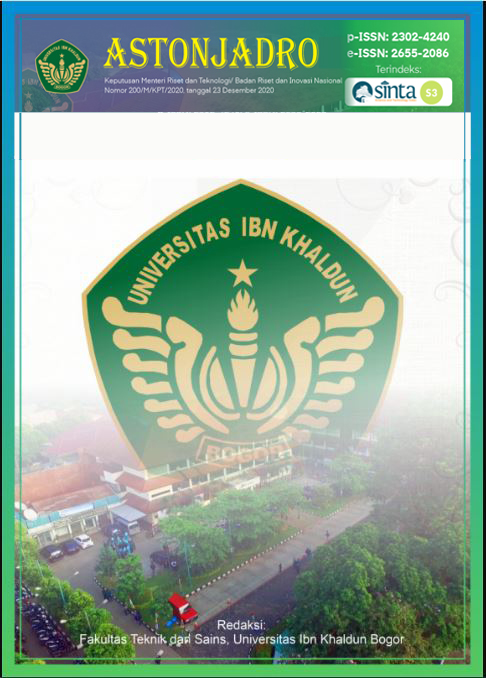Planning Analysis of Asphalt Porous Mixture Based on Fly Ash Waste as Filler Substitution
DOI:
https://doi.org/10.32832/astonjadro.v12i1.8320Keywords:
porous asphalt, coal flyash, ream, pavement, specification.Abstract
In relation to the development of the quality of the transportation system, road pavement technology will gradually develop and be updated in terms of the quality of the transportation infrastructure currently being developed by porous asphalt. Porous asphalt is an asphalt mixture that is designed to have a higher porosity than other types of pavement. it is obtained because the porous asphalt mixture uses a smaller proportion of fine aggregate than other mixtures. In addition to asphalt, there are aggregates both coarse and fine and filler is one of the components in a road pavement construction that has a big role. In order to increase its stability, the use of fine fractions including filler in the mixture proportion should be more. Class C coal fly ash is one of the non-organic and non-plastic materials that can be used as a filler in porous asphalt mixtures and is expected to increase its strength. The purpose of this study was to analyze the effect of using flyash on a porous asphalt mixture on the value of the marshall characteristics and the value of weight loss. The results of this study discuss the marshall test on variations in coal flyash waste 0%, 2%, 3%, 4%, 5%, and 6% using the REAM specification, for the VMA value the percentage of coal flyash waste all meets the specifications specified. has been required, for the VIM value only the percentage of 4% that meet the specifications and 0%, 2%, 3%, 5%, and 6% do not meet the required specifications. For the stability value, the percentage of coal flyash waste 2%,3%,4% met the specifications, while 0%,5%, and 6% did not meet the specifications. For the flow value, the percentage of coal flyash waste 5% did not meet the specifications, while 0%,2%,3%,4%, and 6% had met the required specifications. And for the value of VFB and MQ the percentage of coal flyash waste does not meet the required specifications. Based on the results of the REAM cantabro test, the percentage of coal flyash waste 0% and 2% did not meet the specifications, while 3%,4%,5%, and 6% met the predetermined specifications, namely the maximum weight loss value of 20%.
References
Ayu Lasryza, dan Dyah Sawitri. 2012. "Pemanfaatan Fly Ash Batubara sebagai Adsorben Emisi Gas CO pada Kendaraan Bermotor”. Jurnal Teknik Pomits. Vol. 1. No. 1. Hal : 1-6.
Ash Utilization Division. 2007. ”Fly Ash for Cement Concrete”. Ash Utilization Division. NTPC Limited. Formerly National Thermal Power Corporation Ltd. Diakses 22 April 2022. http://www.ntpc.co.in/ash-download/1674/0/fly-ash-cement-concrete-resourcehigh-strength-and-durability-structure-lower-cost
ASTM D4791 - 19 Standard Test Method For Flat Particles, Elongated Particles, Or Flat And Elongated Particles In Coarse Aggregate.”
Ali, Nur, 2011. Kajian Eksperimental Aspal Porus Menggunakan Liquid Asbuton Sebagai Bahan Substitusi Aspal Minyak pada Lapis Permukaan Jalan. Prosiding 2011.
Atkins, Harold N. 2003. Highway Materials, Soil, and Concrete-4 thed, Pearson Education Inc, New Jersey: Upper Saddle River.
Djumari, Sarwono D., (2009). Perencanaan Gradasi Aspal Porus Menggunakan Material Lokal dengan Metode Pemampatan Kering. Media Teknik Sipil. Vol XI. 9-14
Nugroho, Eko Hindaryanto. Analisis Porositas dan Permeabilitas Beton dengan Bahan Tambah Fly Ash untuk Perkerasan Kaku (Rigid Pavement). Surakarta: Universitas Sebelas Maret, 2010
Pratomo, P. Campuran Hot Rollewed Sheet Dengan Berbagai Jenis Filler. Prosiding Simposium I Studi Transportasi Perguruan Tinggi Bandung: Institut Teknik Bandung, 1999.
Putrowijoyo, Rian. Kajian Laboratorium Sifat Marshall dan Durabilitas Asphalt ConcreteWearing Course (AC-WC) Dengan Membandingkan Penggunaan Antara Semen Portland dan Abu Batu Sebagai Filler. Semarang: Universitas Diponegoro, 2006
Road of Engineering Association of Malaysia, 2008. Specification for Porous Asphalt
SNI-03-1970-1990. "Berat Jenis Dan Penyerapan Air Agregat Halus.”
SNI-03-4142-1996. "Metode Pengujian Jumlah Bahan Dalam Agregat Yang Lolos Saringan No. 200 (0,075 Mm).”
SNI-2417-2008. "Standar Nasional Indonesia Cara Uji Keausan Agregat Dengan Mesin Abrasi Los Angeles.”
SNI-03-1969-1990. "Pengujian Berat Jenis Dan Penyerapan Air Agregat Kasar.”
SNI-03-4428-1997-Agregat-Halus
Tjaronge. M.W & Irmawaty R. (2013). Influence of Water Immersion on Physical Properties of Porous Asphalt Containing Liquid Asbuton as Bituminous Asphalt Binder, Proceedings of 3rd International conference and Sustainable Construction Material and Technologies-SCTM, Kyoto, Japan,2003,M4- 1e153.
Tahir, Anas. Karakteristik Campuran Beton Aspal (AC-WC) dengan Menggunakan Variasi Kadar Filler Abu Terbang Batu Bara. Jurnal SMARTek, 7 (4): 256-278, 2009
Widodo, Sri. Pengaruh Berat Jenis Filler terhadap Karakteristik Campuran Split Mastic Asphalt. Prosiding Simposium III FSTPT, ISBN NO. 979-96241-0-X, 2000
Wignall A., et. Al., 1999. Proyek Jalan Teori & Praktek Edisi Keempat, Jakarta: Erlangga.
Anonim. 2015. National Coal Council "Coal = Reliable Energy”. Diakses 21 April 2022. http://www.nationalcoalcouncil.org/Documents/Energy-Education/4-Coal Reliable-Energy-Final.pdf
Anonim. 2006. Kajian Batubara Nasional "Batubara Indonesia”. Pusat Litbang Teknologi Mineral dan Batubara (tekMIRA). Diakses Tangal 21 April 2022. www.pusdiklat-minerba.esdm.go.id/
Anonim. 2009. International Energy Agency "Key World Energy Statistic”. Head of Communication and Information Office 9 rue de la Fédération, 75739 Paris Cedex 15, France. Diakses Tangal 22 April 2022. https://www.iea.org/publications/freepublications/publication/KeyWorld2017.pdf
Downloads
Published
How to Cite
Issue
Section
License
Copyright (c) 2022 ASTONJADRO

This work is licensed under a Creative Commons Attribution-ShareAlike 4.0 International License.
Paper submitted to ASTONJADRO is the sole property of the Astonjadro Journal. Unless the author withdraws the paper because he does not want to be published in this journal. The publication rights are in the journal Astonjadro.ASTONJADRO
LICENSE
This work is licensed under a Creative Commons Attribution-ShareAlike 4.0 International License.
Based on a work at http://ejournal.uika-bogor.ac.id/index.php/ASTONJADRO













